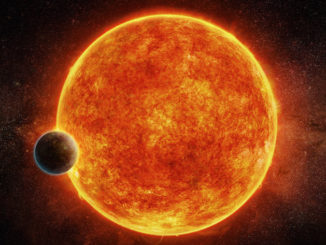
The Hubble Space Telescope has detected heavy metals – iron and magnesium gas – flowing away from a “hot Jupiter” 900 light years away that is orbiting so close to its host star that the exoplanet’s upper atmosphere is heated to a hellish 2,500 degrees Celsius (4,600 Fahrenheit).
Completing one orbit every 1.3 days at a distance of just 3.8 million kilometres (2.4 million miles) from its parent star, the planet, known as WASP-121b, is on the verge of being ripped apart by tidal forces. As it is, the gas giant is likely being gravitationally warped to the point that it would resemble an American football to a nearby observer.
Most other known Jupiter-class exoplanets orbiting close to their host suns remain cool enough deep inside for heaving elements to condense into clouds and remain in place. But that’s apparently not the case with WASP-121b.
“Heavy metals have been seen in other hot Jupiters before, but only in the lower atmosphere,” said lead researcher David Sing of the Johns Hopkins University. “So you don’t know if they are escaping or not. With WASP-121b, we see magnesium and iron gas so far away from the planet that they’re not gravitationally bound.”
Ultraviolet light from the host star, which is hotter than the Sun, heats the planet’s upper atmosphere, helping the magnesium and iron gas to escape.
“We thought we had a chance of seeing heavier elements escaping,” Sing said. “We were mainly looking for magnesium, but there have been hints of iron in the atmospheres of other exoplanets. It was a surprise, though, to see it so clearly in the data and at such great altitudes so far away from the planet.
“The heavy metals are escaping partly because the planet is so big and puffy that its gravity is relatively weak. This is a planet being actively stripped of its atmosphere.”
The observations were made with Hubble’s Space Telescope Imaging Spectrograph, which searched for the signatures of magnesium and iron in the spectra of starlight passing through WASP-121b’s atmosphere as the planet passed in front of its star as viewed from Earth.
The data are helping astronomers better understand how planets lose their initial atmospheres, which are mostly made up of primordial hydrogen and helium from the disc of material that provided the raw material for a solar system’s birth.
“The hot Jupiters are mostly made of hydrogen, and Hubble is very sensitive to hydrogen, so we know these planets can lose the gas relatively easily,” Sing said. “But in the case of WASP-121b, the hydrogen and helium gas is outflowing, almost like a river, and is dragging these metals with them. It’s a very efficient mechanism for mass loss.”
The research is part of the Panchromatic Comparative Exoplanet Treasury (PanCET) survey Hubble is carrying out to survey 20 exoplanets, ranging in size from super-Earths to Jupiter-size worlds across infrared, visible and ultraviolet wavelengths.



